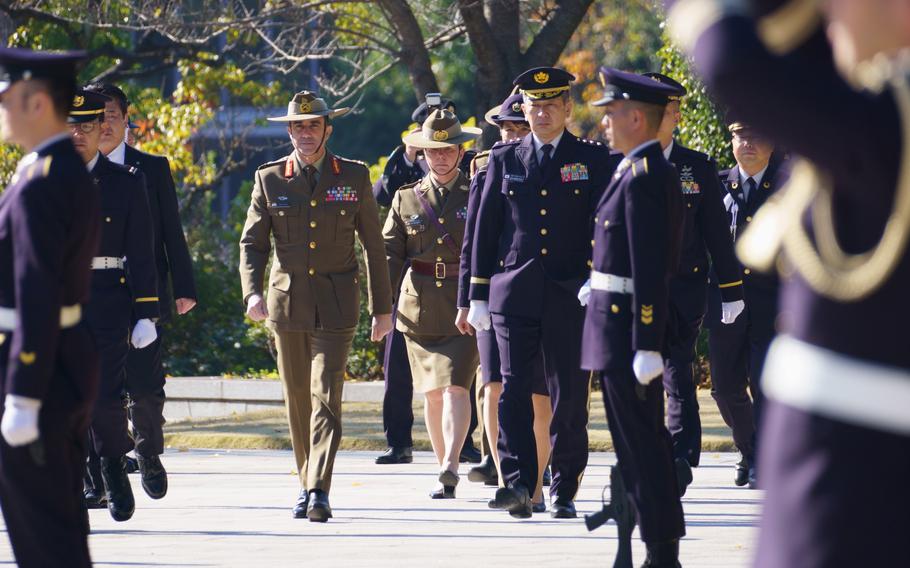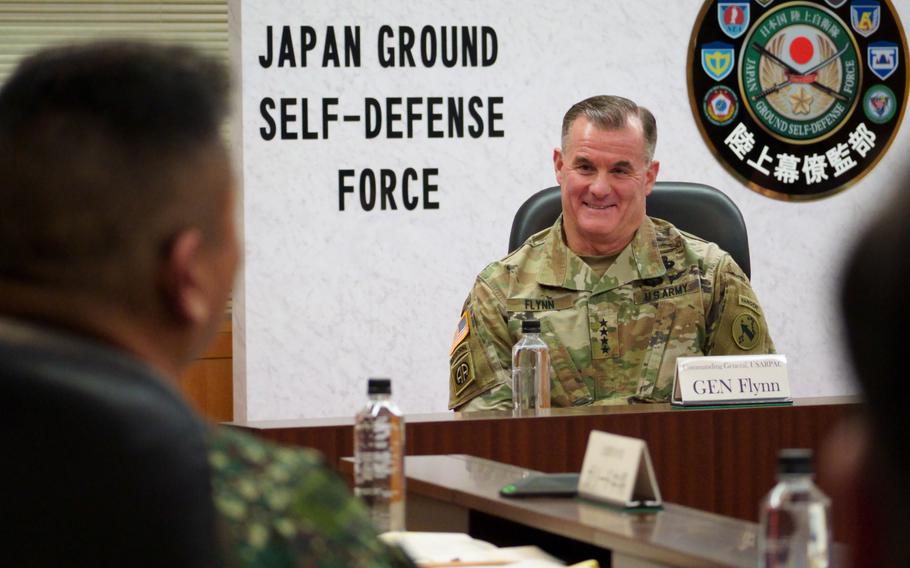
Lt.. Gen. Simon Stuart, Australian Army chief, alongside Gen. Yasunori Morishita, chief of staff for the Japan Ground Self-Defense Force, offer a flower wreath at Japan’s Ministry of Defense in Tokyo on Dec. 15. (Akifumi Ishikawa/Stars and Stripes)
TOKYO — Representatives from four Asian military powers finished two weeks of virtual drills, meetings and other events Friday that strengthen a network of Pacific alliances with the U.S. at its core.
The U.S., Japan and Australia had active roles in Yama Sakura, an exercise held annually since 1982 to prepare for a real attack or natural disaster. The Philippine Army sent observers . The exercise took place at U.S. and Japanese military bases in northern and central Japan.
The U.S. has individual defense treaties with all three nations that it has sought to tighten as regional competition with a strengthening China has increased.
Yama Sakura brings the U.S. Army and Japan Ground Self-Defense Force together for a virtual drill that focuses primarily on communication, coordination and learning about the individual services’ strengths, according to Lt. Gen. Xavier Brunson, commander of the U.S. Army’s I Corps.
“We have to think of these exercises as rehearsals because this [Japan] is sovereign territory, and it’s far more complex than saying ‘Well, we’ve got a treaty,’ ” he told Stars and Stripes by video call on Dec. 7. “Let’s get there and practice how we might do things to support our treaty ally. It’s an opportunity to come together and see how we might benefit an ally.”
The Australian Army, which for the past decade has participated solely as an observer, this year sent about 240 soldiers from its 1st Division to active roles in Hokkaido, Japan’s northernmost prefecture.
“After 10 years of being observers on a really rich and important exercise, the opportunity to be full participants is quite a privilege,” Maj. Gen. Scott Winter, division commander, told Stars and Stripes by phone Dec. 10. “It’s a tremendous opportunity for us to really deepen those trilateral links with the Japanese Ground Self-Defense Force and the U.S. Army.”
During the exercise, the three services coordinated against a theoretical invasion of Japan. Rather than actual field exercises, Yama Sakura typically takes shape through virtual and tabletop scenarios that the U.S. military calls a command post exercise.
The exercise allows commanders to assess their partners’ military prowess and prepares the three countries for emergency contingencies such as humanitarian crises or natural disasters, Brunson said.

Gen. Charles Flynn, commander of U.S. Army Pacific, makes opening remarks during the Land Forces Summit at Japan’s Ministry of Defense in Tokyo on Dec. 13. (Akifumi Ishikawa/Stars and Stripes)
Representatives from the Philippine Army joined the exercise as observers this year; and along with members of the Philippine Marine Corps took part in a summit meeting of the four nations’ military leaders Wednesday and Thursday at Japan’s Ministry of Defense in Tokyo.
“The Philippine Army is transforming from an internally focused operational organization to an external focus on territorial defense,” said Philippine Army commander Lt. Gen. Roy Galido during a leaders’ summit Wednesday. “Our participation here in Yama Sakura has been an eye opener for us on how we should be able to defend our country.”
The summit talks “represent a way for leaders to come together, create bonds and find unity in the efforts that we have towards the future,” Gen. Charles Flynn, commander of U.S. Army Pacific, said in the summit.
The increasing participation of countries other than Japan and the U.S. in Yama Sakura demonstrate the shared goals and hopes of the U.S. and its allies, Brunson added.
“I’d almost call it a cohort of the willing, you know, nations that are really about seeking and maintaining a free and open Indo-Pacific,” he said. “If you go back to Talisman Sabre, everything that we’re doing in the region now is all proceeding by virtue of the fact that nations are showing up.”
The Australian Army hopes for “modest but steady growth” of the number of personnel and level of participation into the future, Winter said.
“We’re certainly looking to sustain the commitment of the 1st Australian Division to exercise Yama Sakura into the future,” he said. “I think as well, though, the opportunity to conduct live field training materials in conjunction with command post exercises is certainly where we’d like to take it.”